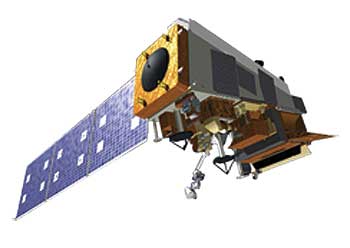
Artist concept of the JPSS-1 spacecraft.
Credit: NOAA/Ball Aerospace
...the Joint Polar Satellite System-1 (JPSS-1) Satellite, NOAA's second next generation operational polar-orbiting satellite, planned to launch in 2017. JPSS-1 will follow the Suomi National Polar-orbiting Partnership (Suomi NPP) satellite to maintain continuity of weather and environmental observations. The final contract was signed on June 19, 2012, with Raytheon Space and Airborne Systems of El Segundo, California, for the Visible Infrared Imager Radiometer Suite (VIIRS) instrument. The Advanced Technology Microwave Sounder (ATMS) contract was signed with Northrop Grumman Electronic Systems in April, 2012. NASA completed the JPSS-1 Spacecraft and the Ozone Mapping and Profiler Suite instrument contract with Ball Aerospace in 2011. The contract to Raytheon Intelligence and Information Systems for the JPSS Ground System was also completed in 2011, as was the Crosstrack Infrared Sounder (CrIS) instrument contract with ITT Exelis.
These instruments form the backbone of space-based observations used for weather forecasting, and environmental and climate monitoring. The ATMS and CrIS instruments onboard JPSS-1 will be used as input for numerical weather prediction models, essential for weather forecasts beyond three days. The JPSS-1 VIIRS instrument will provide imagery that is essential for monitoring severe weather in areas like Alaska and for detecting and tracking volcanic ash and wildfires. It will also gather data on a wide range of Earth's properties, including the atmosphere, clouds, radiation budget, clear-air land and water surfaces, and sea surface temperature.
The instrument contracts include work to build the instruments for the JPSS-1 mission while also providing support services for units previously launched on the Suomi NPP mission in October 2011. All the instruments on NPP have been activated and are operating nominally. For example, preliminary data is being released to aid forecasters and researchers, including images of fires in Southwest Wyoming and Southeast Idaho.
The JPSS program is the restructured civilian portion of the National Polar-orbiting Operational Environmental Satellite System (NPOESS) program and this step represents the final action to transition the instrument contracts to NASA. The contracts are managed by the JPSS program. Data and imagery obtained from JPSS will increase the timeliness, accuracy and cost-effectiveness of NOAA’s public warnings and forecasts of weather and climate events, reducing the potential loss of human life and property. NOAA is responsible for the JPSS program with NASA’s Goddard Space Flight Center in Greenbelt, Maryland, procuring and integrating the system elements.

